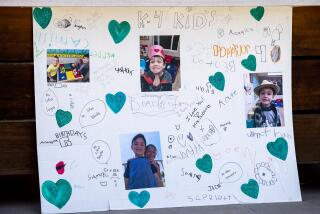Couples on the Road Turn Drive Time Into a Power Trip
- Share via
Like the 6.5 million Californians who the American Automobile Assn. estimates are taking road trips over this year’s holiday season, my family is about to embark on a journey by car. At first blush, such a drive may sound relaxing, even pleasant, since our destination is a mere 21/2-hour jaunt from Los Angeles to San Diego. But what happens between us in a 55-inch-wide passenger compartment isn’t pretty.
My driving drives my husband crazy (he says I go too fast, follow cars too closely and generally put his life, as well as those of our children, at risk).
His freeway driving puts me so on edge that I grip the seat with my thighs as he accelerates into the brake lights of the car in front of us. No matter that neither of us has ever been in a serious accident.
Then there are the perennial issues we argue over, such as whether the sunroof should be open or closed or what is the optimum temperature inside the car. After someone says, “I have to go to the bathroom,” we bicker over how many exits we can pass before actually taking one to stop. And we have yet to resolve the question of how to deal with the intermittent bloodcurdling shrieks exploding from our children, ages 8 and 5, seated behind us.
Naturally this is not a problem for everyone. Some couples forge de facto driving partnerships where the person with the best sense of direction is deemed navigator, while the other, often serving as driver, happily takes orders. But what often happens between a couple in a car’s hermetically sealed, extremely intimate environment is nothing short of a power struggle, according to Pepper Schwartz, a University of Washington sociologist and author of numerous books investigating the dynamics of couples’ relationships.
All too often, she said, the air is filled with loud, judgmental tsk-ing and groaning, let alone character-assassination-style attacks over how turns are taken, use of brakes, speed, lane-changing technique, route choices, whether one is lost, when to stop for breaks and the choice of driving music, if any.
“You can’t underestimate the issue of a car’s smallness of space,” Schwartz said. “What other place are couples so close to each other for that long, except for activities that are pleasurable, like dancing?” (She added that dancing, too, can provoke some of the same problems if there is a question about which partner will lead.) “The car is an awful exhibit of control and naked power,” said Schwartz. “One person has the option to listen or not, and the passenger can only offer suggestions.”
Few other situations present couples with such a zero-sum game scenario, Schwartz added. Every remark has a negative flip side. A passenger’s “you almost sideswiped that car” is heard as “you don’t trust me” by the driver. Surely, in some cases, that would be a correct interpretation.
“Driving in the car together can feel lopsided, arbitrary and unsymmetrical,” said Schwartz. “The driver can dismiss passengers’ right to participate in driving by saying ‘I can handle this,’ which also means ‘I don’t need your help and, by the way, you are not helping.’”
For a couple, the car can be a place where irrationality reigns, emotions run hot and different “driving cultures clash,” said Leon James, professor of psychology at the University of Hawaii in Honolulu. James and his wife, Diane Nahl, a professor of the science of communication at the University of Hawaii, are founders of the field of “driving psychology,” which James (also known as Dr. Driving) began to explore in 1977 while documenting the emotions and thoughts that motivate people when they drive.
“It is tribal warfare in the car; it is family against family, meaning every family has its own driving madness or insanity,” explained James, who, with Nahl, runs www.drdriving.org, a Web site dedicated to raising public awareness about how to change attitudes about driving. “The car is a cultural hot zone. It is irrational. It is like entering into a cultural force field.”
Each family’s value system about driving is passed down from parents to children, as well as through cultural and societal driving norms, which generally are competitive, impatient and territorial, explained Nahl and James, coauthors of “Road Rage and Aggressive Driving: Steering Clear of Highway Warfare” (Prometheus, 2000), in a joint interview by phone from their home in Hawaii.
“Driving brings out some horrific behavior in people, but what it really brings out is how you were raised as a driver,” Nahl said. Changing to a different driving system can feel physically uncomfortable because of previous emotional and physical conditioning to one style, she said. “My father passed on the driving value that you should step on the brake as little as possible, because that wastes gas; it led to aggressive driving. Of course, Leon felt that I went too fast since I was driving without brakes. He used to say I was endangering his life.”
But Nahl was just as uncomfortable with James’ maniacal driving style. Right after the couple married 20 years ago, James commandeered the car to drive Nahl and her 85-year-old, arthritic grandmother. Nahl’s grandmother confided to her granddaughter that she didn’t like the way James drove. Nahl worked up the courage to talk to her husband about the issue, but he was unreceptive and hostile.
“I did not react very well when Diane told me that her grandmother thought I was a bad driver,” said James, who added that the car is a place that encourages resistance to change. “I asked her what she thought was wrong with my driving, and she told me that her grandmother got thrown against the door when I turned.” Nahl admitted that she didn’t like the way James drove either. She told him that he put the blinker on after changing lanes, that he drove too fast and that she was scared.
“I denied it all,” said James, who for a while actually got into a power struggle with Nahl’s grandmother over her backseat driving. “I was insensitive. Then I decided to speak my thoughts out loud as I drove, to see what I was thinking. I was mean and violent. I said, ‘What kind of monster am I?’”
James’ personal awakening came a decade after he asked his students to do the same thing--speak their thoughts and feelings into a tape recorder while driving. (James calls these “self-witnessing” exercises.) When he found that his thoughts echoed theirs, it was a revelation. “I knew it wasn’t a personal issue but a cultural one,” said James. “I realized the truth about myself, and I realized it was a socialization problem, not an anger problem. I developed a three-step method to change: Acknowledge, witness and modify. The first is the hardest--admitting [to being] an aggressive driver--especially for men.”
The second step, said James, requires witnessing oneself being mean, by keeping a driving diary noting things that provoke anger and/or speaking thoughts aloud into a tape recorder. To modify, James recommends that lousy drivers address one habit at a time, such as tailgating, yelling obscenities or refusing to move over so a car can pass.
Galvanized by their own friction, James and Nahl modified their driving habits and developed something called a “partnership driving agreement” for people who travel together, whether they are friends, members of a car pool or a family. The contract, available on their Web site, endows passengers with the right to tell the driver how to drive (in a nice voice, please) and prohibits the driver from retaliating.
“Basically we look at the passengers as prisoners who are captive but who do have human rights,” said Nahl. “We have gotten letters from couples who have said the contract has worked for them and improved their relationship.”
The contract designates the passenger as a partner in the driving, but it needs to be renewed regularly. Here are some excerpts:
“As my driving partner, I authorize you to express yourself freely about my driving and promise not to retaliate in any form. I agree that you, my designated driving partner, will be the sole judge of whether I am retaliating or not.”
“If I lose my control and you find that I’m retaliating against you, I agree to compensate you for each incident in accordance with our Fair Compensation Agreement. (Note: This is something that you need to negotiate and agree upon prior to the trip, and will no doubt vary with different people.)”
“I agree that the purpose of designating you as my driving partner is to help me to know myself more objectively as a driver. This means letting you observe me and comment on my driving in accordance with your feelings and analyses of each incident. This kind of exchange will help me reach my goal of becoming an emotionally intelligent and supportive driver.”
The agreement is meant to be informal, said James, who in 1997 testified before Congress about road rage. If the contract is too bothersome, James and Nahl suggest drivers try the “Costanza technique,” which requires that the driver (assuming he or she has the personality of an ill-tempered pit bull) do and say the exact opposite of his or her impulses. The idea harks back to an episode of “Seinfeld” in which the ne’er-do-well character George Costanza did the exact opposite of what he wanted to, and in the process improved his life.
“When you are behind the wheel of the car and you do and say the opposite of what you feel, it will put you in a positive zone,” said James, who now readily takes suggestions from his wife to wave drivers in front of him and takes care not to cut too close to pedestrians crossing the street.
*
Birds & Bees, a column about relationships and sexuality, runs Monday. Kathleen Kelleher can be reached at [email protected].






